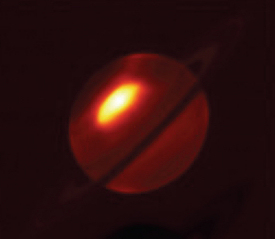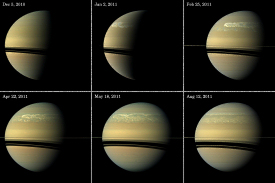Giant storms cause palpitations in Saturn's atmospheric heartbeat
13 December 2017
Immense northern storms on Saturn can disturb atmospheric patterns at the planet's equator, finds the international Cassini mission. This effect is also seen in Earth's atmosphere, suggesting the two planets are more alike than previously thought.| Temperature changes at Saturn's equator: 2004-2016. (Click here for details and large versions of the video.) Credit: ESA/NASA |
Despite their considerable differences, the atmospheres of Earth, Jupiter, and Saturn all display a remarkably similar phenomenon in their equatorial regions: vertical, cyclical, downwards-moving patterns of alternating temperatures and wind systems that repeat over a period of multiple years.
These patterns–known as the Quasi-Periodic Oscillation (QPO) on Saturn and the Quasi-Quadrennial Oscillation (QQO) on Jupiter, due to their similarities to Earth's so-called Quasi-Biennial Oscillation (QBO)–appear to be a defining characteristic of the middle layers of a planetary atmosphere.
 |
| VLT image of a giant anti-cyclone in Saturn's stratosphere on 20 July 2011. Credit: Image courtesy of Leigh N. Fletcher, University of Oxford, UK, and ESO |
Earth's QBO is regular and predictable, repeating every 28 months on average. However, it can be disrupted by events occurring at great distances from the equator of our planet–and a new study reveals that the same is true of Saturn's QPO.
"These oscillations can be thought of as a planet's heartbeat," says Leigh Fletcher of the University of Leicester, UK, lead author of the study (published in Nature Astronomy) and co-investigator of Cassini's Composite Infrared Spectrometer (CIRS). "Cassini spotted them on Saturn about a decade ago, and Earth-based observations have seen them on Jupiter, too. Although the atmospheres of the distant gas giants may appear startlingly different to our own, when we look closely we start to discover these familiar natural patterns."
Cassini observed Saturn from June 2004 until 15 September 2017 when the mission concluded by plunging into the gas planet's atmosphere. To better understand Saturn's QPO, Fletcher and colleagues studied data from Cassini's CIRS covering this entire time period.
"We looked at data of Saturn's 'heartbeat', which repeats roughly every 15 Earth years, and found a huge disturbance–a palpitation, to continue the metaphor–spanning 2011 to 2013, where the whole equatorial region cooled dramatically," adds co-author Sandrine Guerlet from Laboratoire de Météorologie Dynamique (LMD), France. "When we checked the timing, we realised this happened directly after the eruption of a giant storm that wrapped around Saturn's entire northern hemisphere. This suggests a link between the two events: we think that the wave activity associated with this huge storm headed towards the equator and disrupted the QPO, despite the storm raging tens of thousands of kilometres away!"
This storm was known as the Great Northern Storm. Such storms occur roughly once every Saturnian year, which is equivalent to 30 Earth years. The timing of the storm was thus serendipitous, allowing Cassini to observe it in detail from orbit around the ringed planet.
 |
| Saturn's Great Northern Storm of 2011. Credit: NASA/JPL-Caltech/Space Science Institute |
Although the influence of Saturnian storms was known to be substantial, this study suggests an even wider influence than expected, and confirms a connection between Saturn's QPO and remote, distinct events occurring elsewhere in the planet's atmosphere.
 |
| Saturn's Great Northern Storm in visible light. Credit: NASA/JPL-Caltech/Space Science Institute |
"We became especially excited when we compared this palpitation on Saturn to one observed in Earth's QBO in 2016: it was disturbed in a similar way by waves carrying momentum from Earth's northern hemisphere to the equator," adds Fletcher. "That disruption was unprecedented in over 60 years of monitoring the QBO–and yet we were lucky enough to capture a similar behaviour at work on Saturn with Cassini."
On Earth, this relationship between distant events in a planet's climate system is known as teleconnection. Meteorological patterns across the globe are known to be delicately linked together, and can affect one another quite significantly. A key example of this is the El Niño Southern Oscillation, which can influence temperatures and climate patterns across the Earth.
"It's remarkable to see this process occurring on another planet within our Solar System–especially one that's so vastly different to our own," says Nicolas Altobelli, ESA Project Scientist for the Cassini-Huygens mission.
"Cassini-Huygens may now have ended its mission, but there's still a wealth of data to explore, and a huge amount of valuable information to be gathered from the spacecraft's observations. As well as telling us more about Saturn, gas giant planets, and the Solar System in general, this study helps us better understand the Earth. This is one key driver of our research into other planets: to discover more about our own."
Notes for Editors
The paper "Disruption of Saturn's quasi-periodic equatorial oscillation by the Great Northern Storm" by L. N. Fletcher et al. is published in the journal Nature Astronomy. doi:10.1038/s41550-017-0271-5.
The Principal Investigator of Cassini's Composite Infrared Spectrometer (CIRS) is Michael Flasar (NASA/GSFC, USA).
Cassini-Huygens is a cooperative project of NASA, ESA, and ASI, the Italian space agency.
More information on the mission can be found here.
For further information, please contact:
Leigh Fletcher
University of Leicester, UK
Phone: 0116 252 3585
Email: leigh.fletcher![]() le.ac.uk
le.ac.uk
Sandrine Guerlet
Laboratoire de Météorologie Dynamique (LMD), France
Email: sandrine.guerlet![]() lmd.jussieu.fr
lmd.jussieu.fr
Nicolas Altobelli
ESA Cassini-Huygens Project Scientist
Directorate of Science
European Space Agency
Phone: +34 91 813 1201
Email: nicolas.altobelli![]() esa.int
esa.int




